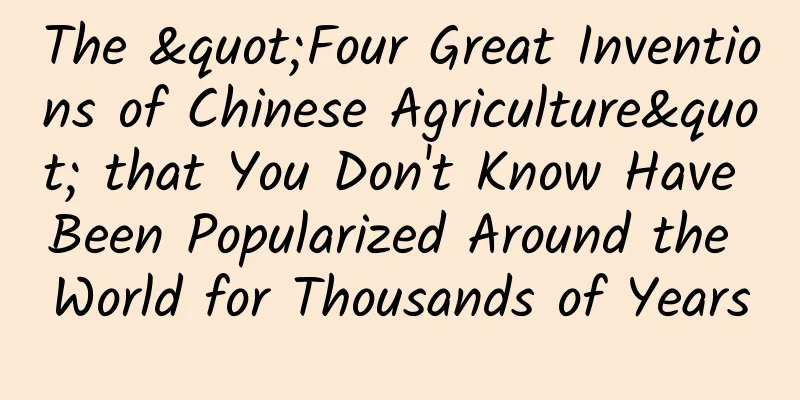The "Four Great Inventions of Chinese Agriculture" that You Don't Know Have Been Popularized Around the World for Thousands of Years

|
Silk, rice, tea and soybeans are known as the four great inventions of Chinese agriculture. In the view of some scholars, the importance of the "four great inventions of agriculture" may far exceed that of the "four great inventions". China's four great agricultural inventions. | Tuchong Creative Author | Yang Jintao Everyone knows that China has the so-called "Four Great Inventions" - papermaking, printing, the compass and gunpowder. Few people know that China also has the "Four Great Agricultural Inventions", namely rice cultivation, soybean production, sericulture and silk reeling, and tea cultivation and processing. The latter concept was proposed by Professor Wang Siming, Dean of the Institute of Chinese Agricultural Civilization at Nanjing Agricultural University and a famous agricultural historian. He believes that "the idea of the Four Great Inventions is a completely Western concept, emphasizing the impact of these inventions on Western mercantilism, industrialization, and social change." In Professor Wang Siming's view, the importance of the "Four Great Inventions of Agriculture" far exceeds that of the "Four Great Inventions." Professor Wang Siming. |China Science and Technology Press Unlike the controversial "Four Great Inventions" - the Si Nan has not been restored to this day, and movable type printing has almost been lost in ancient times, the invention rights of the "Four Great Inventions of Agriculture" can basically be locked in China. Like the "Four Great Inventions of Agriculture", the "Four Great Inventions of Agriculture" were spread abroad one after another after their birth. As Professor Wang Siming said in a paper, "In the long-term agricultural exchanges between China and foreign countries, a large number of crops domesticated and cultivated by the ancestors of successive generations of China, including the 'Four Great Inventions of China', were spread abroad and gradually became the common wealth of all mankind." Silk Along the Silk Road Let's talk about silk first. Ancient China was called China or Serica. There are many different opinions about the origin of the former. It may be the transliteration of "Qin" or "Zhi Na", and it is also used to refer to porcelain; the latter is usually considered to be the transliteration of "reeling silk" - because silk is a specialty of China, it has become a synonym for China. The history of silkworm breeding and reeling in China is indeed long. As early as 7,000 to 5,000 years ago, silkworm cocoon specimens and the earliest existing silk fabrics were found in the Yangshao culture site. Jade silkworms were often unearthed in the tombs of the Shang Dynasty and the Western Zhou Dynasty. Around silk, an important commodity, the prototype of the Silk Road gradually emerged. In particular, in the 2nd century BC, Zhang Qian opened up the Western Regions, allowing Chinese silk, porcelain, lacquerware and other products to be sold smoothly to the West. As the scale of product exports expanded, related technologies such as sericulture and silk making were introduced to the Western Regions around the 3rd century; around the 5th century, they were introduced from the Western Regions to Persia; and later, the Eastern Roman Empire also acquired silk weaving technology from the Western Regions or Persia. People in the Southern and Northern Dynasties already knew that the people of Daqin (i.e. the Eastern Roman Empire) could raise silkworms, grow mulberry trees and weave brocade. Silk, along with the emergence of the Silk Road. | Tuchong Creative Rice is widely grown in Southeast Asia Unlike silk, which spread from east to west, rice spread from China to the east and south, first becoming popular in Southeast Asia, North Korea, South Korea, Japan, etc. The history of rice domestication by Chinese ancestors can be traced back to the Neolithic Age. In the Hemudu cultural site dating back more than 7,000 years, archaeologists discovered abundant rice grains, rice leaves and rice stalks, which are very different from wild rice. Between 4000 and 3000 BC, rice was introduced to northeastern Thailand through the Red River Basin in Vietnam, and was then widely planted in Southeast Asia. Around 1000 BC, the Korean Peninsula had already introduced rice from the Shandong Peninsula and the Liaodong Peninsula. Later, rice was introduced to Japan through the Korean Peninsula. According to the research in the book "Rice" in the series, Chinese rice can be found even in Africa and the Americas. Chinese rice is widely grown in Southeast Asia. | Tuchong Creative Soybean is a latecomer in America Another food crop listed as one of the "Four Great Inventions of Agriculture" is soybeans. Wild soybeans are distributed all over the world, and Chinese wild soybeans are most similar to cultivated soybeans, indicating that soybean domestication may have been completed in China. Archaeological sites in Heilongjiang, Jilin and other provinces have discovered soybean remains dating back more than 3,000 years. Carbonized soybean particles were also found in the famous Mawangdui Han Tomb in Changsha. The spread of soybeans in Asia is similar to that of rice. It first spread from mainland China to the Korean Peninsula, and then from the Korean Peninsula to the Japanese archipelago. The soybean cultivation in Southeast Asia was later than that in East Asia. Japan used soybeans to invent unique soy products such as miso and natto. Around the 16th century, Western missionaries came to China and Japan and brought soybeans back to Europe. After the mid-18th century, soybeans were introduced to North America. By 1954, the United States surpassed China to become the country with the largest soybean production and export in the world. South American countries introduced soybeans relatively late, but thanks to the promotion of genetically modified soybeans, Argentina now produces tens of millions of tons annually, ranking third in the world. Genetically modified soybeans have greatly promoted soybean production in America. | Tuchong Creative Tea Drinks Popularized by the Japanese Among the "four great agricultural inventions", silk, rice and soybeans mainly solved people's basic food and clothing problems, but tea drinking was different. It was more often regarded as a pastime besides food and clothing. Wild tea trees are widely distributed in southwest China, but for a long time, only the people of Bashu drank tea. After that, with the occupation of Bashu by the Qin State, tea drinking gradually became popular in southern China and then in northern China. The origin of tea is different from that of silk, rice, soybeans, etc. Tea was brought to Japan by the Tang Dynasty envoys, and was integrated into the Buddhist thought by Japan, inventing the "tea ceremony" that has lasted to this day. More than 1,000 years later, Westerners first saw tea from the Dutch. There are some quite different ways to drink tea in Europe. For example, the British add sugar and milk to tea, and the Russians also add honey. Tea is drunk all over the world, but in different ways. | Tuchong Creative The article is published by "China Science and Technology Press" (ID: cspbooks). Please indicate the source when reprinting. |
>>: Painting Story | What makes cherries, the “top New Year’s product”, so expensive?
Recommend
How to unlock your phone if you forget your password? No need to spend money to flash the phone, just press 2 buttons in 10 seconds and it will be done
In daily life, when using mobile phones, no matte...
Last night, their story went viral!
Last night (3rd) "2021 China Moved People&qu...
Tips for using Erdua, a mobile web debugging tool
One of the biggest pain points in mobile web deve...
Can’t tell the difference between information flow advertising, DSP, ad networks and SEM?
Many people don’t know the differences between in...
Marketing Analysis | How to reshape customer experience and increase customer lifetime value!
How to retain existing customers is a major issue...
Why are the old domestic appliances from 20 years ago so durable?
After a full twenty years of service, a domestic ...
Why can't Baidu's autonomous driving retain talents and become a Huangpu Military Academy? Independent split may be the only way forward
It can be said that Baidu’s talents support half ...
Three major trends in smartphones in 2022: shrinkage, price cuts, and squeezing
At the beginning of last year, Huawei, once the l...
Why do I feel so tired even though I just sit all day at work?
Everyone has probably experienced this moment at ...
Heavy rainstorms and heavy rainstorms will start tonight! Please keep this guide to avoid and save yourself from heavy rainstorms and floods
From the night of 18th A new round of rainfall is...
How much does it cost to make a WeChat mini program for the beauty and hairdressing industry?
How much does it cost to make a WeChat mini progr...
If your jeans are full of bacteria (the nice kind)
We wear jeans in all styles and colors, but there...
KOC will be the main force of Douyin e-commerce in the future!
In the era of short videos , not everyone who tri...
He is known as a "stubborn ranger" and has identified the sources of more than 20 major rivers around the world with his team.
On February 22, Rolex announced the winners of th...









